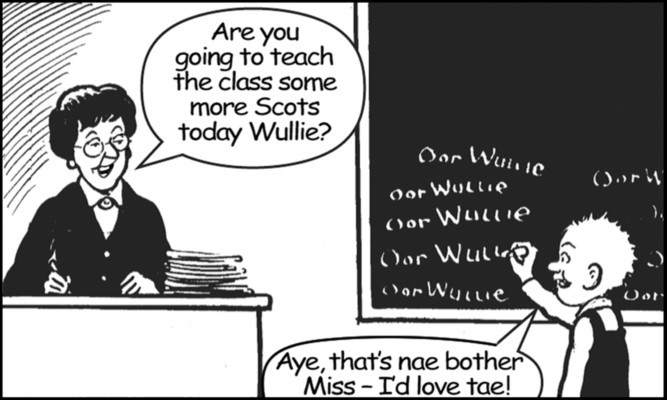Much-loved comic strip character Oor Wullie is to help children learn Scots through an online initiative developed by the National Library of Scotland.
The “Oor Wullie’s guide tae Scots language” website aims to introduce six to 11-year-olds to the richness of the Scots tongue.
It has been produced in association with publisher DC Thomson, which has featured the Oor Wullie comic strip in the Sunday Post since 1936.
Describing itself as “a guid fun wey tae lairn oor language” the site features activities such as quizzes, word searches, flash cards and the opportunity for children to design their own comic.
Other features include a glossary of words such as “fantoosh”, “bampot” and “muckle” as well as poems and songs and an audio map which allows children to submit a recording of their own use of Scots to help build up a picture of dialects across Scotland.
Dr Alasdair Allan, minister for Scotland’s languages, said: “As someone who has grown up reading about Oor Wullie’s adventures, I am delighted to be one of the first people to try out the website. Scots is a fantastic language with brilliantly descriptive words like dreich, slitter or wheesht.
“Each of these may have a comparable word in other languages but translations just don’t capture how expressive and illustrative the original Scots is.
“The last census showed an incredible 1.5 million people have some knowledge of Scots or uses it regularly, which is a wonderful achievement when you consider that many people from previous generations were discouraged from using it.
“This site brings together a huge amount of expertise and the activities allow pupils to express themselves in a fun way that shows how popular Scots is across the country.”
The website has been developed with input from pupils and teachers at a number of Scottish schools.
The Scots Language Centre, the Scottish Language Dictionaries, the National Trust for Scotland and the Robert Burns Birthplace Museum are all partners in the project.
National librarian Dr John Scally said: “The Oor Wullie guide tae Scots language website uses a fun approach to the serious business of learning and can be accessed by primary schools all across Scotland.
“It has been designed to fit with the Curriculum for Excellence and aims to help children develop high level skills in listening, talking, reading and writing which are essential for learning, work and life.”
Other characters from the comic strip such as Soapy Joe, Wee Eck, Fat Boab and Pc Murdoch also appear on the site, as do Primrose and Wullie’s teacher.
Oor Wullie editor Morris Heggie said: “The Scots language is an important part of Scottish culture and it has been a pleasure working with the National Library of Scotland on this project.
“Oor Wullie has been fair thrilled at the response from school children and everyone involved with the strip is rooting for the project to be a huge success.”
